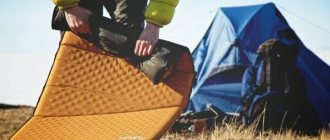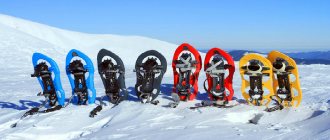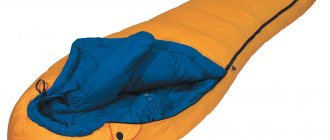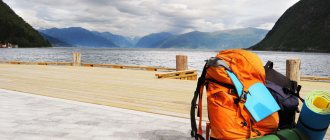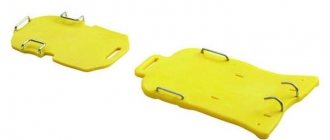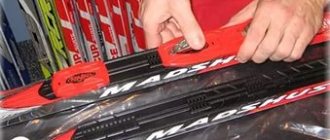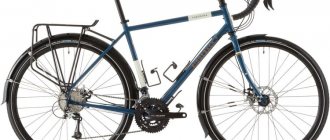The first thing that is associated with a hike is a big-eared backpack, on the sides of which hang mats rolled into a tight roll (aka foam). But in a real campaign there are fewer and fewer such “ears”. Thin, hard foam, although it does a good job of insulating the cold of the earth and preventing you from freezing, is still far from the most comfortable option. Some might argue that this is done for the sake of weight. Yes, you can't argue with that. At the moment, there are only a few companies making self-inflating carpets that weigh less than foam. For example, the Therm-a-rest ProLite Small mat weighs 310 grams, versus 350 grams for regular foam. But at the same time, it is very tiny when assembled, which cannot be said about the foam.
Overall, when we talk about self-inflating backpacking rugs, it will generally be a trade-off: how much more weight can we afford to take in order to gain in comfort and volume. And whether the rug is designed for comfort or compactness will determine its “specialization.”
Travel mats
Lightweight, self-inflating carpets that fold into a small cylinder are designed for hiking. As a rule, their thickness varies from 2.5 to 3.8 centimeters. You can take a five-centimeter thickness if it is folded in half when packing and you are ready for its volume and weight.
Photo: James Barkman
Typically self-inflating carpets are rectangular. But big name brands like Therm-a-rest prefer a more ergonomic shape that tapers towards the legs and head to reduce weight. Some rugs can also be shortened for extreme volume and weight savings. Which is applicable, for example, to climbers. In this case, it is calculated that the person will place his head, torso and pelvis on the carpet, while leaving his feet on the ground.
Even with such a small thickness, sleeping on such carpets is much more comfortable and softer than on foam, and the thermal insulation is much higher. Self-inflating carpets inflate themselves to their natural state. If this is not enough, you can blow it up to the desired thickness. The main thing is not to make the mistake of all beginners, not to inflate the mat completely. The fact that the mat bends under the weight of your body is precisely what ensures comfort. And if you inflate it to the limit, you will not only lose comfort, but you may also tear the rug if you lean on it suddenly.
How does a self-inflating mattress work?
Now let's learn more about how a self-inflating mattress works. The operating principle is as follows: when the air valve opens, the foamed material inside begins to expand like a spring, absorbing air. After a few minutes, the valve can be closed and the mat is ready for use.
Air mattress device
Often there are cut air channels inside the filler. Due to them, you can not only reduce weight, but also make it easier to fold or inflate, since air spreads through the channels faster.
Camping mats
Large, comfortable rugs designed for camping. They are thicker than travel ones and can reach 12 centimeters in thickness, such as the Outwell Dreamcatcher Single XL 12 mat.
In addition, they are usually wider, but take up a lot of space when folded and weigh several kilograms. For example, the width of BTrace Luxary 10 is 76 centimeters, which is quite large for a single-seat carpet; it is quite large when folded - a cylinder 80 centimeters long.
These rugs are not for hiking; they are too heavy and large to carry on your back. They are taken for camping. When traveling by car or when parked for a long time, both weight and volume mean much less to you than comfort.
Camping rugs are not only soft, but also sometimes smooth out very serious unevenness under the tent due to their thickness, for example, tree roots or mole holes. This allows you to less carefully choose a place to set up a tent.
Self-inflatable mattress for a tent
A self-inflating mattress (mat) is a real breakthrough in evolution. The top layer of the mat is a durable material; inside it contains porous foam, which instantly absorbs air between the cells. Therefore, when the valve is opened, it inflates itself. The foam provides thermal insulation even when there is no air inside. It compresses easily, so the air instantly “comes out.” The level of insulation depends on the thickness of the model.
Air-inflated mattresses are an excellent alternative to “hard” traditional mattresses
Today, manufacturers are conducting various experiments: adding down or synthetic insulation, and also using heat-reflecting materials (aluminized coating). Such models are compact in size, have good thermal insulation and are relatively inexpensive.
Main advantages:
- Compactness. When folded, such a thing does not take up much space, so it can be placed in a backpack, for example, in the top flap.
- Comfort. When inflated, it will provide comfortable sleep not only on a flat surface, but also on a winding, convex surface (bumps, stones).
- Thermal insulation. For self-inflating models, this figure can reach 9.5, so they provide protection from the cold even at a temperature of -48 degrees.
- Long service life. With proper care and proper use, they will last more than 10 years.
In addition, a self-inflating tourist mattress has two disadvantages :
- It costs more than a traditional karemat. And this is obvious, because modern models with good thermal insulation, light weight and compactness simply cannot be cheap. However, such an investment is worth it to ensure comfortable sleep in warmth at any time of the year and in any conditions, and not for one year.
- Requires careful care and careful operation. Many are afraid of getting pierced. However, high-quality models from trusted manufacturers are covered with durable, wear-resistant fabric. Therefore, they can be placed on stones and hummocks in an inflated form and nothing bad will happen. The main thing is not to overdo it: you shouldn’t cut sausage on them, for example, or plop down on top with a bunch of ice screws on your belt.
This equipment is suitable for any type of outdoor activity - mountain tourism, mountaineering, hiking and cycling, as well as trekking, camping, winter and ski trips.
What is the difference between an air mattress and a self-inflating one?
Let's look at an example: the Outwell Flock Classic Pillow & Pump Double air bed. Large and tall, inflated. Heavy, but small when folded. The main disadvantage of air mattresses and beds is thermal insulation. When you sleep on a self-inflating carpet, you are separated from the ground by voluminous foam and the walls of the carpet itself. When you sleep on an air mattress, you are separated from the ground by two thin layers of matter and air. Air mattresses do little to insulate you from the cold ground.
We recommend taking air mattresses when you plan to sleep indoors. For example, as a temporary option for the country house. If you plan to spend the night in a tent at a campsite, then even in the warm season, coolness may come from the ground in the morning. And it’s better to play it safe than to jump up from the cold in the wee hours.
What a sleeping bag should NOT be
No matter how “extremely warm” a sleeping bag is, it is not enough for a relaxing rest in a tent. The heat capacity of the soil is very high, and without thermal insulation the body will experience discomfort. Even if you fall asleep on the rocks of the Black Sea coast that have warmed up during the day, you can wake up from the cold in the morning. How can you help yourself?
Let's start, as mathematicians say, “by contradiction.” When going to a store to buy a camping tent, many people ask for an air mattress that fits the width. This is a mistake for which you can pay not only with poor sleep, but also with health problems. The synthetic material from which the air bed is made and the air inside (subject to mixing) are not sufficient heat insulators.
First, the ground cools, then the air in the mattress and the tourist’s back. What to do? If funds are limited, you will have to sacrifice comfort for health and make do with a classic polyurethane foam mat. It has one drawback - rigidity.
But there are several advantages: excellent thermal insulation (I myself slept on one in a winter tent on ice), small weight and transport volume, unpretentiousness to operating conditions (not afraid of punctures and temperature changes). The sizes are, as a rule, standard - 60x180 cm. While the body was young enough and I did not experience problems with muscles numb from an uncomfortable position, I got by with a simple rug.
And even now sometimes I get by. Mats made of polyethylene foam with a ribbed surface resembling a washboard have good characteristics. They help out on uneven surfaces. Their significant drawback is volume. In general, “foams” have not yet been forced out of the tourism goods market and, I think, will be in demand for a long time.
I just want to warn you against buying foil-lined polyethylene foam mats. This material is used in construction and is not intended for use under load. It quickly loses its properties, ceases to take its original shape after use and crumples under weight.
We'll help you with the selection
We will always be happy to help you with the selection of equipment for your outdoor recreation. You can easily reach us by phone. Or write to us on WhatsApp at the number,.
We recommend coming to our retail store on Shabolovka, 23, here you will find the largest selection of models from popular brands, you can compare them live and get professional expert advice and advice on choosing.
Just 5 years ago, self-inflating mats were the preserve of a select few, they were incredibly expensive and were the envy of owners of simple tourist foams.
Last year, 2021, we started selling thousands of them. They became affordable and people understood the difference between ordinary foam and high-quality sanitary inflatable carpet.
This is just a different level of quality - like between a grandmother’s mattress and an orthopedic one.
Remember how you tossed and turned at night, cursing a pine cone or a tree root that dug into the foam, accidentally unnoticed before setting up the tent - now this is no longer there. The mat covers uneven surfaces and makes rest truly comfortable; the air layer protects against hypothermia. Plus, it is useful at home and after a hike - you don’t need to keep a folding bed for unexpected guests and relatives - you can use a rug - it’s convenient and comfortable.
Our selection of the best tents in various categories:
Self-inflating mats
Essentially, they are a sheet of low-density polyurethane foam (or simply high-quality foam rubber) in a water- and airtight shell with a valve for air access. Polyurethane foam is an open-porous material obtained from the processing of petroleum products. It compresses easily and also easily restores its shape. Due to the fact that polyurethane foam is able to let air in, and the shell prevents this air from escaping, rugs made of this material, with a relatively low weight and packaging size, retain heat well. You just need to unroll the mat and open the air valve. The foam inside will absorb air on its own. You will only need to inflate a little to give the necessary rigidity and close the valve. That's all! The mat takes up very little space in the backpack, and in terms of comfort it far surpasses all “foams”. It effectively smoothes out all the unevenness of the terrain and provides good softness. You just need to avoid tap dancing with crampons on it and protect it from sparks.
The first self-inflating mat called “Therm-A-Rest Foam Pad” was released in 1972 by the American company Cascade Designs. Since then, Therm-A-Rest brand mats have been one of the undoubted leaders in the production of this segment of travel equipment. By its fortieth anniversary in 2012, the company had sold more than 15 million rugs worldwide. The variety of models, the use of our own new technologies, excellent workmanship (mats are produced only in factories in Seattle (USA) and Cork (Ireland) have ensured Therm-A-Rest mats respect and love among tourists and climbers.
Currently, Therm-A-Rest mats are available in 3 series: “Fast & Light”, “Trek & Travel” and “Camp & Comfort”.
The “Fast & Light” series, as the name implies (literally “fast and light”) is intended for those who value the light weight of equipment: climbers, light walkers and simply those who do not like to carry a large load. The ProLite, ProLite Plus and ProLite Apex models are 2.5, 3.8 and 5 cm thick with an R-value of 2.4, 3.4 and 4.0 respectively, providing excellent levels of heat conservation and comfort at low weight. They are available in several sizes, which allows you to individually select a mat for users of different heights and builds. There are also special women's models. They are distinguished by a smaller size compared to the standard one and a higher R-value - for lovers of the warmest and most comfortable sleep.
Mat Self-inflating THERM-A-REST prolite plus regular poppy
10 850
Mat Self-inflating THERM-A-REST prolite large poppy
12 700
Mat Self-inflating THERM-A-REST prolite plus regular mountain print
10 820
Self-inflating mat THERM-A-REST women's prolite plus cayenne
10 850
The “Trek & Travel” series is suitable for those who value comfort along with light weight. The shell fabric is denser than the Fast & Light series and provides better puncture resistance. The rugs in this series are the most versatile: they are light enough for mountain hikers and climbers, but are also suitable for campers and other lovers of comfortable outdoor recreation.
Mat Self-inflating THERM-A-REST women's trail lite regular grasshopper
7 550
Mat Self-inflating THERM-A-REST women's trail pro mint
10 400
Self-inflating mat THERM-A-REST trail pro large gecko
12 700
Mat Self-inflating THERM-A-REST trail lite large smokey pine
8 490
The “Camp & Comfort” series is designed for those whose priority is not light weight, but comfort. This is an excellent choice for family vacation lovers, campers and base camp residents. Excellent thermal insulation, comfortable rectangular shape, softness - for many, these advantages more than offset disadvantages such as heavy weight and packaging volume.
Rugs from the Australian company Sea To Summit have also proven themselves in business. Models Ultra light, Camp mat, Comfort plus with a thickness of 2.5, 3.8 and 8 cm with an R-value of 2.6, 4.0 and 4.1, respectively, will satisfy both fans of lightweight equipment for summer hikes and those who needs a good winter rug. The distinctive features of this company's rugs are their own developments. This is also a special reversible valve that prevents air from entering the carpet while it is being rolled up, so it can be rolled up much more compactly without any additional effort. And Delta Core technology is a system of chambers of different volumes; in the areas of maximum contact of the mat with the body (shoulders, hips, feet) the chambers are small for greater rigidity, and in other areas where the pressure is not so strong, on the contrary, the chambers are larger, due to which it was possible to reduce the weight of the mat by 20 percent without reducing its thermal insulation properties. The Pillow Lock system for fixing the pillow is also interesting. With its help, you can attach the Sea To Summit Eros inflatable pillow to a rug from the same company with Velcro. Agree, it’s convenient when your pillow doesn’t “move” anywhere from under you while you sleep. In addition, the rugs from this company, while of very good quality, compare favorably with competitors in price.
new
Inflatable mat Sea To Summit ultralight self inflating mat large orange
9 600
Buy
Self-inflating mat Sea To Summit comfort plus self inflating regular red
13 000
Self-inflating mat Sea To Summit comfort plus self inflating large red
15 000
new
Inflatable mat Sea To Summit camp mat self infl rect reg wide olive
8 640
Buy
new
Inflatable mat Sea To Summit camp mat self inflating large olive
8 640
Buy
Self-inflating mats are also produced by Russian companies, such as Red Fox and Trek Planet, and if the products of the latter, due to their large weight, will be of interest mainly to campervans, then Red Fox mats are perfect for lovers of summer tourism. And if you use their mats complete with “foam”, then we can talk about four-season use. Lightweight travelers should pay attention to the Red Fox Pro Mat Light model. She weighs a little less than half a kilogram. Very compact when folded. With a length of 150 cm, it is enough to put a backpack under your feet, and an inflated pillow or just a bag with clothes under your head - and the sleeping place is ready.
Mat Self-inflating Red Fox pro mat light 150x51x2.5 amber/asphalt
4 900
The Italian company Salewa produces two models of self-inflating mats: the large, comfortable, but rather heavy Mat comfort and the lightweight Mat lite. Both models are perfect for camping and light hiking.
athlete price
Self-inflating mat Salewa mat comfort applegreen/grey
9 990
Buy
athlete price
Self-inflating mat Salewa mat lite pacific blue/grey
7 990
Buy
